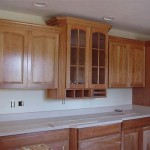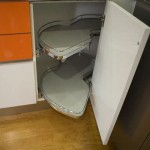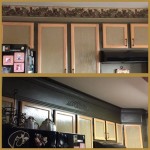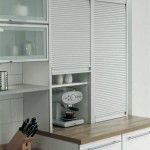Tips for Cleaning Grease Off Kitchen Cabinet Doors
Kitchen cabinet doors, especially those located near the stove, are particularly susceptible to accumulating grease. This greasy film, often mixed with dust and food particles, can be challenging to remove and can detract from the overall appearance of the kitchen. Regular cleaning and the use of appropriate techniques are essential to maintaining the cleanliness and aesthetic appeal of kitchen cabinets. This article provides several methods and tips for effectively cleaning grease off kitchen cabinet doors, ensuring a spotless and well-maintained kitchen environment.
Understanding the Nature of Grease and Its Removal
Grease, primarily composed of fats and oils released during cooking, is hydrophobic, meaning it repels water. This characteristic makes it difficult to dislodge with water alone. Over time, grease can harden and become sticky, further complicating the cleaning process. Effective grease removal requires the use of solvents or emulsifiers that can break down the fatty bonds and allow the grease to be lifted away from the cabinet surface. The type of cleaning agent and technique used will depend on the severity of the grease buildup and the material of the cabinet doors.
Before starting any cleaning process, it is crucial to identify the type of material your kitchen cabinet doors are made of. Common materials include wood (painted, stained, or laminated), laminate, metal, and thermofoil. Each material reacts differently to cleaning agents, and using the wrong product can cause damage, discoloration, or warping. Always test any cleaning solution in an inconspicuous area first, such as the inside of a cabinet door, to ensure it doesn't damage the finish. This precautionary step can save time and prevent costly repairs.
Furthermore, the age of the grease deposits plays a significant role in the difficulty of removal. Fresh grease is easier to clean than grease that has been allowed to accumulate and harden over time. Regular cleaning routines, such as wiping down cabinets weekly, can prevent the buildup of stubborn grease and simplify the cleaning process. Establishing a consistent cleaning schedule minimizes the need for intensive cleaning sessions and helps maintain the cabinets' original appearance.
Effective Cleaning Solutions and Techniques
Several readily available household products can be used to effectively clean grease off kitchen cabinet doors. These solutions often provide a balance between cleaning power and safety for various cabinet materials. Common options include dish soap, baking soda, vinegar, and commercial degreasers. The selection of the appropriate solution depends on the cabinet material, the age and severity of the grease buildup, and personal preferences regarding chemical exposure.
Dish Soap:
A mild solution of dish soap and warm water is often the first line of defense against grease. Dish soap contains surfactants that help to emulsify grease, allowing it to be rinsed away. To use this method, mix a few drops of dish soap in a basin of warm water. Dip a soft cloth or sponge into the solution, wring out the excess water, and gently wipe the greasy surfaces. Rinse the cloth frequently in clean water to avoid spreading the grease. After wiping down the cabinets, dry them thoroughly with a clean, dry cloth to prevent water spots and potential damage.Baking Soda:
Baking soda is a mild abrasive that can help to scrub away stubborn grease without damaging most cabinet finishes. To use baking soda, create a paste by mixing it with a small amount of water. Apply the paste to the greasy areas and gently scrub with a soft cloth or sponge. Avoid using excessive force, as this can scratch the surface. Rinse the area thoroughly with clean water and dry completely. For particularly stubborn grease, baking soda can be combined with dish soap and water to create a more potent cleaning solution.Vinegar:
Vinegar, specifically white vinegar, is a natural degreaser that can effectively break down grease and grime. Its acidity helps to dissolve the fatty acids in grease, making it easier to wipe away. To use vinegar, mix equal parts white vinegar and warm water in a spray bottle. Spray the solution onto the greasy areas and let it sit for a few minutes to allow the vinegar to penetrate the grease. Wipe down the cabinets with a clean, damp cloth and dry thoroughly. The distinctive smell of vinegar dissipates quickly, but if it is bothersome, lemon juice can be added to the solution for a more pleasant scent.Commercial Degreasers:
When household solutions are insufficient, commercial degreasers can provide a more powerful cleaning action. These products are specifically formulated to dissolve grease and grime quickly and effectively. However, it is essential to choose a degreaser that is safe for the specific type of cabinet material. Always read the product label carefully and follow the manufacturer's instructions. Test the degreaser in an inconspicuous area before applying it to the entire surface. Wear gloves and eye protection when using commercial degreasers to avoid skin and eye irritation.Regardless of the cleaning solution used, the application technique is crucial for achieving optimal results. Always use a soft cloth or sponge to avoid scratching the cabinet surface. Avoid using abrasive scrubbers or scouring pads, as these can damage the finish. Wipe in the direction of the wood grain, if applicable, to prevent streaks. Rinse frequently and dry the cabinets thoroughly after cleaning to prevent water damage and maintain their appearance.
Specific Considerations for Different Cabinet Materials
The material of the kitchen cabinet doors significantly impacts the selection of appropriate cleaning methods and solutions. Using the wrong product on a particular material can lead to irreversible damage. Therefore, understanding the specific cleaning requirements of each cabinet material is essential for maintaining their longevity and appearance.
Wood Cabinets (Painted or Stained):
Painted and stained wood cabinets require gentle cleaning methods to avoid damaging the finish. Avoid using harsh chemicals or abrasive scrubbers, as these can strip the paint or stain. A mild solution of dish soap and warm water is generally safe for painted wood cabinets. For more persistent grease stains, a paste of baking soda and water can be used sparingly. Stained wood cabinets can also be cleaned with a mixture of vinegar and water, but it's important to dry them immediately to prevent water from seeping into the wood. Oil-based wood cleaners and polishes can also be used to maintain the luster of stained wood cabinets.Laminate Cabinets:
Laminate cabinets are generally more durable and resistant to damage than wood cabinets. They can withstand a wider range of cleaning solutions, including dish soap, vinegar, and mild all-purpose cleaners. Avoid using abrasive cleaners or scouring pads, as these can scratch the laminate surface. Wipe laminate cabinets with a damp cloth to remove dirt and grime, and dry them thoroughly to prevent water spots. Laminate cabinets are generally easy to clean and maintain, making them a popular choice for kitchens.Metal Cabinets:
Metal cabinets are typically durable and resistant to grease and grime. They can be cleaned with a variety of solutions, including dish soap, vinegar, and commercial degreasers. However, it's important to choose a cleaner that is specifically designed for use on metal surfaces to avoid corrosion. Stainless steel cleaners are ideal for stainless steel cabinets, while other metal cabinets can be cleaned with mild all-purpose cleaners. Wipe metal cabinets with a soft cloth to avoid scratching the surface, and dry them thoroughly to prevent water spots and rust.Thermofoil Cabinets:
Thermofoil cabinets are made of a thin layer of vinyl that is heat-sealed onto a fiberboard core. They are generally easy to clean but are susceptible to damage from heat and excessive moisture. Avoid using harsh chemicals or abrasive cleaners on thermofoil cabinets, as these can damage the vinyl coating. A mild solution of dish soap and warm water is typically sufficient for cleaning thermofoil cabinets. Wipe them with a soft cloth and dry them thoroughly to prevent moisture from seeping into the fiberboard core. Avoid placing hot appliances or cookware directly on thermofoil cabinets, as this can cause the vinyl to peel or blister.Selecting the appropriate cleaning method and solution requires careful consideration of the cabinet material and the severity of the grease buildup. Testing any cleaning solution in an inconspicuous area before applying it to the entire surface is always a prudent step. By employing the correct techniques and using the right products, kitchen cabinet doors can be effectively cleaned and maintained, preserving their appearance and extending their lifespan.

How To Clean Sticky Grease Off Kitchen Cabinets Ovenclean

How To Remove Grease From Kitchen Cabinets 3 Methods Bob Vila

How To Remove Grease From Kitchen Cabinets Easy Cleaning Tips Wooden Clean

How To Clean Kitchen Cabinets Everyday Skate

How To Clean White Kitchen Cabinets 3 Best Ways Avoid Abbotts At Home
:max_bytes(150000):strip_icc()/ways-to-clean-wood-kitchen-cabinets-3017289-Hero-01-8dd7662e6528441d9eb0e6569fc83fde.jpg?strip=all)
Tips For Cleaning Food Grease From Wood Cabinets

How To Clean Kitchen Cabinet Hardware And Knobs

How To Clean Sticky Grease Off Kitchen Cabinets

How To Clean Your Kitchen Cabinets

How To Quickly Clean Cabinets Remove Grease Gunk Andrea Jean
Related Posts








